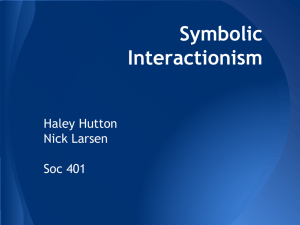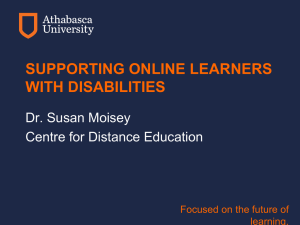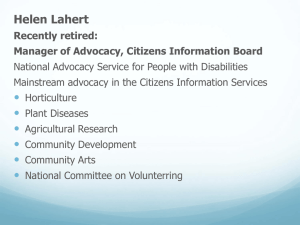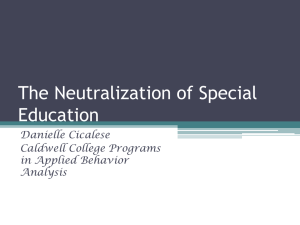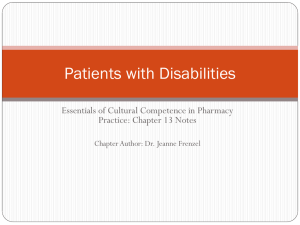Powerpoint® Instructional Alignment - MAST
advertisement
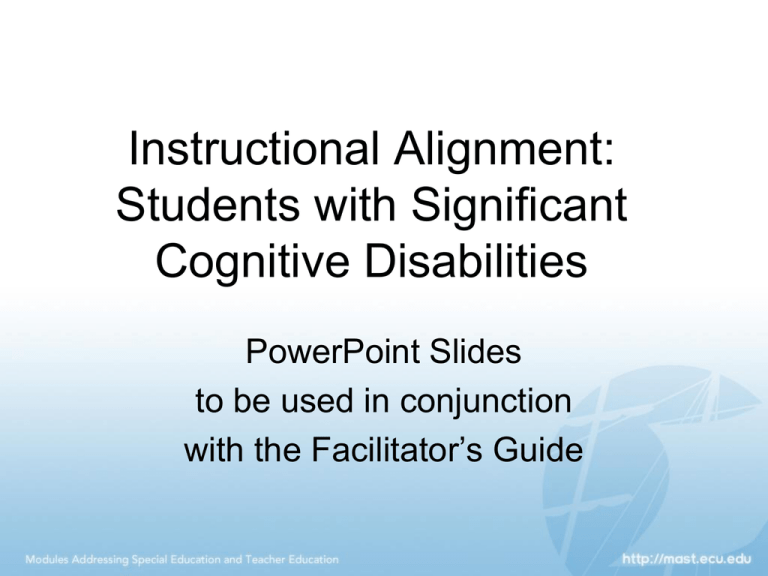
Instructional Alignment: Students with Significant Cognitive Disabilities PowerPoint Slides to be used in conjunction with the Facilitator’s Guide Copyright © 2011, East Carolina University. Recommended citation: Jimenez, B., & Henderson K. (2011). Instructional alignment: Students with significant cognitive disabilities– A PowerPoint presentation for professional development. Modules Addressing Special Education and Teacher Education (MAST). Greenville, NC: East Carolina University. This resource includes contributions from the module developer and MAST Module Project colleagues (in alphabetical order) Kelly Henderson (Facilitator Guide Editor), Tanner Jones (Web Designer), Diane Kester (Editor), Sue Byrd Steinweg (Project Director), Bradley Baggett (Graduate Assistant), and Sandra Hopfengardner Warren (Principal Investigator). Session Agenda • • • • • • Introduction Session Goals and Objectives Overview Legal Requirements Least Dangerous Assumption Alternate Assessments based on Alternate Achievement Standards Session Agenda, continued • • • • 8 Criteria for Instruction Alignment Working-It-Across Summary Evaluation Introduction • General curriculum access is a "hot topic" in the field of special education for students with significant intellectual disabilities. • Recent federal policy (IDEA and NCLB) have promoted access to the general curriculum with expectations for all students to show adequate yearly progress on state standards in language arts, math, and science. Introduction, continued • Educators struggle to adapt the general curriculum content to meet the individual needs of their students, while defining academic achievement expectations. • Listen to the description of teacher Mr. Green at http://mast.ecu.edu/modules/udl_ia/introdu ction/#1 . Introduction, continued • Recent literature affirms that students need to have full access to the general curriculum via opportunities to learn academic content that is closely linked to their grade-level standards. • It is important for educators to know how to develop instructional plans that have a standards-based focus, taking into account students' individual needs. Introduction, continued • Most students with significant cognitive disabilities operate at one of three Levels of Symbolic Communication. • The symbolic levels are designed to help students access content within any subject area, while remaining aligned to the general education standard. Introduction, continued • The access skills for the Abstract Symbolic level include: – Uses vocabulary of signs, pictures, and words to communicate. – Recognizes some sight words, numbers, etc. – Some symbols are abstract (e.g., yesterday, happy, 9:00). Introduction, continued • The access skills for the Concrete Symbolic level include: – Beginning to use pictures or other symbols to communicate within a limited vocabulary, primarily concrete symbols (e.g., eat, drink, outside, play). Introduction, continued • The access skills for the Pre-Symbolic level include: – Communicates with gestures, eye gaze, purposeful moving to object, sounds; communication is purposeful (e.g., hold up cup for drink). Introduction, continued • Symbolic levels are not specific to motor response a student has. • For example, a student who is blind may use objects to respond, but can understand access to curriculum at an abstract symbolic level. • In science, objects are typically usually used to teach concepts within models or diagrams. Introduction, continued • A student who uses a model of the layers of earth to understand the earth's structure is an example of an abstract symbolic level of access, even though it is with an object. • Almost all students will fall into one of the three ways to access the curriculum symbolically. However, a small percentage of students may not currently have a consistent motor response (ex., don’t consistently point or eyegaze). Introduction, continued • A student who can yell consistently to get food has a consistent response. That yelling behavior can be shaped to become a means for responding. • But those students who really don't have a consistent mode of response would be considered to be at an Awareness level. Introduction, continued • For students at an Awareness level, plan instruction around a Pre-symbolic level and work to build communication skills within the actual content. • For now, it is impossible to measure what they know, but using the content to work towards communication is a great way to create access for that small percentage of students. Session Goal and Objectives • The goal of this session is to describe the eight criteria for instruction alignment and to generate a planning strategy that can be used to align state standards in any content area based on how students symbolically access the curriculum. The module will discuss the alternate achievement standards, grade-level alignment, symbolic levels, and response modes for students with significant intellectual disabilities. Session Goal and Objectives Objectives: Participants will be able to: 1. Identify the eight criteria for instruction alignment for students with significant intellectual disabilities. 2. Identify examples of each of the eight criteria for instruction alignment. 3. Select appropriate modes of response for a wide variety of student characteristics. Objectives, continued 4. Apply knowledge of the "Work-It-Across" strategy used to plan grade-aligned instruction for students grades K-12 across core content areas (Englishlanguage arts, math, and science) using Symbolic Levels. 5. Identify grade-aligned instruction and the criteria used to develop instruction for students who access the curriculum at various symbolic levels in grades K-12. Overview • Why Access? It is very important that educators of students with significant intellectual disabilities understand the why and how of instruction for this population of student. • In this session we will address both of these difficult topics and build a framework of what instruction should look like for students with severe disabilities and why this framework is so important. History of Education for Students with Severe Disabilities • Over the past several decades the field of special education has changed dramatically. • The following slides are located at http://mast.ecu.edu/modules/udl_ia/lib/ media/slides01/SlideShow.html The History of Special Education for Students with Significant Intellectual Disabilities 1970s 197580s 1980 1990s 1990s 2000s Adapted from: Browder, D. M., Spooner, F., Ahlgrim-Delzell, L., Flowers, C., Karvonen, M., & Algozzine, R. (2003). A content analysis of the curricular philosophies reflected in states’ alternate assessment performance indicators. Research and Practice for Persons with Severe Disabilities, 28(4), 165-181. Developmental Model 1970s • PL 94-142 • Piagetian levels of development But . . . • Not age appropriate • Some students may get “stuck” 1975 80s Functional Curriculum • Deinstitutionalization; • Criterion of Ultimate Functioning (Brown, Nietupski & Hamre-Niertupski, 1976) • Life Skills • Teaching to independence • Personalized curriculum = IEPs Missing: Literacy (limited to sight words) Opportunity for a full educational experience Social Inclusion 1980s • Philosophy of Normalization (Wolfensburger, 1972) – Full membership in schools; community – Civil rights – peer relationships Missing: Content Mastery Academic inclusion Self-Determination 1990s • Goal Setting • Problem Solving • Person-Centered Planning 1990s2000s General Curriculum Access ACADEMICS • Curriculum Overlapping • Need both Social and Functional (Snell & Brown, 2000; Westling & Fox, 2000) Academics Functional Social Overview, continued • Let’s Review! The field of special education has surely come a long way in the past several decades. While the field has changed from the 1960’s and 1970’s, research and practice from those decades have helped design our thinking and education of students with disabilities to what it is today. Legal Requirements • In the preceding slides, the changes in special education over the past several decades were discussed. As noted on several of the slides, legal mandates have driven much of the reform. • Next are links to more information on some of the legal mandates that have greatly influenced the field of special education on general curriculum access. PL 94-142 & IDEA http://www.scn.org/~b In 1975, Congress passed Public Law k269/94-142.html 94-142 (Education of All Handicapped Children Act), now codified as IDEA (Individuals with Disabilities Education Act). In order to receive federal funds, states must develop and implement policies that assure a free appropriate public education (FAPE) to all children with disabilities. The Elementary http://www2.ed.gov/po Signed into U.S. law in 2002, seeks to and Secondary licy/elsec/leg/esea02/in increase accountability for student Education Act as dex.html performance in public schools. reauthorized by the No Child Left Behind Act of 2001 Least Dangerous Assumption "The criterion of least dangerous assumption holds that in the absence of conclusive data, educational decisions ought to be based on assumptions which, if incorrect, will have the least dangerous effect on the likelihood that students will be able to functional independently as adults" (Donnellan, 1984, p. 141). Least Dangerous Assumption, continued • In 2005, Cheryl Jorgenson revisited the concept of Least Dangerous Assumption to challenge the field of special education to attack their very own ideas and perceptions. • Instead, the assumption is all students can, will, and should be taught with respect and high expectations. Least Dangerous Assumption, continued • Read “The Least Dangerous Assumption” by Cheryl Jorgenson at http://mast.ecu.edu/modules/udl_ia/lib/d ocuments/The_Least_Dangerous_Assu mption_A_Challenge_to_Create_a_Ne w_Paradigm.pdf . • We will always presume competence! Alternate Assessments based on Alternate Achievement Standards • IDEA states “children with disabilities must be included in general state and district-wide assessment programs, with appropriate accommodations, where necessary.” • Where accommodations alone cannot make these assessments accessible, agencies must develop additional assessments so that every child will be included in the accountability programs. Alternate Assessments, continued • School accountability systems have been created by each state to track student progress in the areas of English/language arts, math, & science. • Students with severe disabilities often participate in alternate assessments designed by their state department of education. Alternate Assessments, continued • There are several versions of alternate assessments (e.g., portfolio, checklists). For students with severe disabilities, the main difference in the assessment should be the level of performance the student is required to meet on grade-level content. • The remainder of this session will address strategies and a system to develop aligned curriculum to prepare students for alternate assessments. 8 Criteria for Instruction Alignment • Let’s look at a model for creating instruction aligned to grade level content. • Based on the work at the University of North Carolina at Charlotte, 8 criteria for academic alignment were developed. • Watch the slide show (copies follow) at http://mast.ecu.edu/modules/udl_ia/lib/medi a/slides02/SlideShow.html to learn about steps to develop well-aligned instruction, The 8 Criteria for Alignment. Alignment • A match between the written, taught, and tested curriculum Curriculum Instruction Project NAAC OSEP Grant #H324U040001 Assessment UNC at Charlotte Considerations in planning aligned instruction • Criteria for determining Alignment of AAAAS to the General Curriculum – Browder, D. M., Wakeman, S. Y., Flowers, C., Rickelman, R. J., Pugalee, D., & Karvonen, M. (2007). Creating access to the general curriculum with links to grade level content for students with significant cognitive disabilities. Journal of Special Education, 41(1), 2-16. – Flowers, C., Wakeman, S., Browder, D., & Karvonen, M. (2007). Links for academic learning: An alignment protocol for alternate assessments based on alternate achievement standards. Charlotte, NC: University of North Carolina at Charlotte. Project NAAC OSEP Grant #H324U040001 UNC at Charlotte Criteria 1: The Content is Academic Self check: I am familiar with my state standards. I know the major strands of math, science, language arts/ reading. I collaborate with general education teachers. Project NAAC OSEP Grant #H324U040001 UNC at Charlotte Challenge your thinking related to functional skills. Is washing hands academic? Is there a way to embed academic skills within the steps of teaching a child to wash their hands? 40 Criteria 2: Start at the Student’s Grade level/band • Middle School (Grades (6-8) • Literature of Focus: The Cay by Theodore Taylor • Students read chapters of book on grade level – Make diagram (e.g., fishbone) of story events describing cause and effect with evidence. – Identify facts and opinions related to the characters. – Write a narrative comparing Phillip’s quality of life before and after the boat accident using evidence from the text. • Some overlapping content with different performance expectations by grade band (e.g., Grade 3= student will match details to main ideas by / Grade 5= student will identify the main idea and supporting details) Project NAAC OSEP Grant #H324U040001 UNC at Charlotte Criteria 3: Content and Performance (when possible) Matches with Standard • State Standard: – Identify and analyze forces that cause change in landforms over time • Content – Forces that shape landforms • Performance – Identify and analyze Adapted from NAAC (2005) Project NAAC Example #1: Camilla will activate switch to listen to a science story about landforms. – Content? No – Performance? No Example #2 Camilla will use pictures to identify forces (wind, water, ice) – Content? Yes – Performance? Some Example #3 Camilla will select force and match with landform change (picture, model) – Content? Yes – Performance? Stronger link OSEP Grant #H324U040001 UNC at Charlotte Criteria 4: DOK (depth of knowledge) and Breadth • Not all expectations for DOK is at lower levels (awareness, memorize, recall vs. evaluate, compare/contrast, apply) – Bloom’s Taxonomy • Academic skills for students cross the breadth of content standards (students are provided instruction and assessed on multiple standards) Project NAAC OSEP Grant #H324U040001 UNC at Charlotte For permission to replicate or use contact Dr. Browder at dbrowder@uncc.edu http://education.uncc.edu/access/ The Expected Achievement Level Differs from Grade Level • Examples of Alternate Achievement for The Cay – Students hear chapter summaries read and participate using pictures, repeated story lines, and controlled vocabulary. – Students select pictures for fishbone diagram (cause/effect) after hearing story. – Students use pictures to answer simple questions about characters in the story (e.g., Was Phillip on a boat or airplane?). – Students compare events from their own life to events in Phillip’s life in the story using a yes/no chart, and a Venn diagram. Project NAAC OSEP Grant #H324U040001 UNC at Charlotte Criteria 5: Expect Some Differentiation in Content across Grade Levels/Bands • Review standards and instruction for: – Broader application – Deeper application – Prerequisite skills (expected in building some content areas) – New skills – Identical (only a few) • Curriculum Mapping Project NAAC OSEP Grant #H324U040001 UNC at Charlotte Criteria 6: Student Achievement vs “Something Else” • Student achievement – Select picture for main idea • Full credit- eye gaze, point – Find main idea across stories – More credit for more complex text Project NAAC • “Something Else” – Select picture with model prompt- point where I point – Student works with peer who selects the picture – Student listens to story (aka: sits quitely) OSEP Grant #H324U040001 UNC at Charlotte Criteria 7:Barriers to Participating • Minimize potential barriers • Can students with various sensory, physical, communication challenges “show what they know”? • What supports do students need to interact with content? • How will students who use pre-symbolic communication or who have limited intentional communication meaningfully participate? • How will students with low vision/no vision and/or hearing impairments participate? Project NAAC OSEP Grant #H324U040001 UNC at Charlotte Criteria 8: Using “Best Practice” • Best practice instruction to promote learning in the general curriculum – Self determination – Inclusion – Systematic instruction – Team planning – Positive behavior support – Assistive technology Project NAAC OSEP Grant #H324U040001 UNC at Charlotte Project NAAC OSEP Grant #H324U040001 UNC at Charlotte 49 8 Criteria, continued • The slides reviewed the 8 criteria, what there are and how they are useful when planning instruction for students with significant intellectual disabilities. • It may be helpful to refer to these criteria when planning a unit of instruction, individual lesson plan, and/or IEP goals and objectives. 8 Criteria, continued • Another valuable reference is: • Browder, D. & Mims, P. (2010, April). Planning for Instructional Alignment. Paper presented at the 2010 conference of the Council for Exceptional Children, Nashville, TN. Available at http://www.naacpartners.org/presentatio ns/presentations/national/CEC/5100.pdf Working-It-Across • Each state developed their own standards that all students are expected to master within a given grade or grade band. • State departments of education work with content experts in the fields of science, English/language arts, math, and social studies to develop performance objectives that develop students understanding an application of content, building depth and breadth of understanding. Working-It-Across, continued • Becoming familiar with your state standards is an essential component in order to provide meaningful gradealigned instruction to students with significant intellectual disabilities. • Let’s take a look at a sample state standard and objectives. Competency Goal 2: The learner will make observations and conduct investigations to build an understanding of landforms. Objectives 2.01 Identify and analyze forces that cause change in landforms over time including. Water and Ice. Wind. Gravity. 2.02 Investigate and discuss the role of the water cycle and how movement of water over and through the landscape helps shape land forms. 2.03 Discuss and consider the wearing away and movement of rock and soil in erosion and its importance in forming: Canyons. Valleys. Meanders. Tributaries. 2.04 Describe the deposition of eroded material and its importance in establishing landforms including: Deltas. Flood Plains. 2.05 Discuss how the flow of water and the slope of the land affect erosion. 2.06 Identify and use models, maps, and aerial photographs as ways of representing landforms. 2.07 Discuss and analyze how humans influence erosion and deposition in local communities, including school grounds, as a result of: Clearing land. Planting vegetation. Building dams Source: North Carolina Department of Public Instruction, http://www.ncpublicschools.org/curriculum/science/scos/2004/1 7grade5 Working-It-Across, continued • In the competency goal, all students are expected to be taught this content and students should be able to demonstrate competency in the content. • This is a difficult goal for students with significant intellectual disabilities. But through strong instructional alignment using the eight criteria for planning we can create instruction for all students to “show what they know.” Working-It-Across, continued • Using a process called "Work-It-Across" developed by Dr. Diane Browder and colleagues, students’ symbolic levels are taken into account to plan grade-aligned instruction for all students. • Watch slide show at http://mast.ecu.edu/modules/udl_ia/lib/medi a/slides03/SlideShow.html to learn more about the process. A copy of the slides follows. • We can “Work it Across”! Developed by Bree Jimenez(2010); Modified from Browder, Wakeman, Flowers, Rickelman, Pugalee, & Karvonen, (2007). Grade Level Standard: Typical Expectation (Not adapted) Student Symbol Use Presentation of content; adapted for Symbol level Student performance Activity (how do you teach the skill at each level?) Reads/writes at or near grade level Abstract Symbolic Concrete Symbolic Pre Symbolic 7th Grade Level Standard: Demonstrate an understanding of Earth’s lithosphere. On grade level Expectation (Not adapted) Student Symbol Use Reads/writes at or near grade level Presentation of content; adapted for Symbol level Text book, video on SMART Board, model of Earth’s layers (graham crackers/frosting) Student performance Identify what layers of Earth are part of the lithosphere and the properties that allow movement. Activity (how do you teach the skill at each level?) Group read passage from text; watch video and answer questions; cooperative learning groups interact with model of Earth and answer question. Abstract Symbolic Concrete Symbolic Pre Symbolic 7th Grade Level Standard: Demonstrate an understanding of Earth’s lithosphere. On grade level Expectation (Not adapted) Abstract Symbolic Student Symbol Use Reads/writes at or near grade level Reads some words, uses pictures symbols, understands some abstract pictures and concepts Presentation of content; adapted for symbolic level Text book, video on SMART Board, model of Earth’s layers (graham crackers/frosting) Adapted text, words/pics for key vocab., video on SMART Board; model of Earth’s layers Student performance Identify what layers of Earth are part of the lithosphere and the properties that allow movement. Point to and name the two layers of Earth that form the lithosphere (crust and upper mantle). Move plates (graham crackers) to show how plates can move past each other, or into each other. Activity (how do you teach the skill at each level?) Group read passage from text; watch video and answer questions; cooperative learning groups interact with model of Earth and answer question. Group read passage (adapted text); watch video answer quest. With pic. sym options; cooperative learning groups with model; Fill in Concept Statement “Big Idea”. Concrete Symbolic Pre Symbolic 7th Grade Level Standard: Demonstrate an understanding of Earth’s . On grade level Expectation (Not adapted) Abstract lithosphere Symbolic Concrete Symbolic Student Symbol Use Reads/writes at or near grade level Reads some words, uses pictures symbols, understands some abstract pictures and concepts Reads picture symbols; can follow picture cues, may identify very common words (name; lunch) Presentation of content; adapted for symbolic level Text book, video on SMART Board, model of Earth’s layers (graham crackers/frosting) Adapted text, words/pics for key vocab., video; model of Earth’s layers Adapted text with pictures; video on SMART Board; model (may pair with pic sym) Student performance Identify what layers of Earth are part of the lithosphere and the properties that allow movement. Point to and name the two layers of Earth that form the lithosphere (crust and upper mantle). Move plates (graham crackers) to show how plates can move past each other, or into each other. Point to and label (pic sym) the two layers of Earth that form the lithosphere. Move plates to show how plates move past or into each other. Activity (how do you teach the skill at each level?) Group read passage from text; watch video and answer questions; cooperative learning groups interact with model of Earth and answer question. Group read passage (adapted text); watch video answer quest. With pic. sym options; cooperative learning (CL) groups with model; fill in concept statement (CS) with Big Idea. Group read passage (adapted text); watch video; fill in “concept statement” with pic symbol. CL groups w/model, match picture (vocab.). Pre Symbolic 7th Grade Level Standard: Demonstrate an understanding of Earth’s . On grade level Expectation (Not adapted) Abstract lithosphere Concrete Symbolic Symbolic Pre-Symbolic (Beginning with Symbols) Student Symbol Use Reads/writes at or near grade level Reads some words, uses pictures symbols, understands some abstract pictures and concepts Reads picture symbols; can follow picture cues, may identify very common words (name; lunch) Read with a few digital pictures, objects to communicate, want/needs Presentation of content; adapted for symbolic lvl Text book, video on SMART Board, model of Earth’s layers (graham crackers/frosting) Adapted text, words/pics for key vocab., video; model of Earth’s layers Adapted text with pictures; video on SMART Board; model (may pair with pic sym) Adapted text paired with objects; video on SMART Board; model (paired with rocks, soil, clay) Student performance Identify what layers of Earth are part of the lithosphere and the properties that allow movement. Point to and name the two layers of Earth that form the lithosphere (crust and upper mantle). Move plates (graham crackers) to show how plates can move past each other, or into each other. Point to and label (pic sym) the two layers of Earth that form the lithosphere. Move plates to show how plates move past or into each other. ID land materials as Earth’s lithosphere; Move graham crackers (paired with materials) when asked to move the “Earth’s Plates”. Activity (how do you teach the skill at each level?) Group read passage from text; watch video and answer questions; cooperative learning groups interact with model of Earth and answer question. Group read passage (adapted text); watch video answer quest. With pic. sym options; cooperative learning (CL) groups with model, fill in Concept statement for Big Idea. Group read passage (adapted text); watch video; fill in “concept statement” with pic symbol. CL groups w/model; match pic for vocab. Group reading (adapted text); watch video; fill in CS with object. CL group w/model & land materials. Working-It-Across, continued • This model can be used to take any state standard and plan instruction that is aligned and provides all students a way to “show what they know”. • Teachers can use Work-It-Across to practice “thinking” about alignment. • The process may not be practical for teachers to write down for each standard to be taught within the school day year. Working-It-Across, continued • However, the Work-It-Across strategy can be used by planning teams as an “thinking” exercise to plan 1 or 2 standards each week or for a given theme (e.g., solar system). • The more you practice “thinking”, the easier the process of extending standards and working them across becomes. • More examples of Work-it-Across in multiple content areas and levels are available at: Working-It-Across, continued South Carolina Department of Education http://ed.sc.gov/agency/Accountability/Asses sment/old/assessment/programs/swd/Exam plesofInstruction.html General http://education.uncc.edu/access/parenttips. Curriculum Access htm Projects @ UNC Charlotte (Instructional Resources) Working-It-Across, continued • While this strategy is used to extend any state standard and create access for all students, many states have developed support documents and provide ideas for extending standards. • The most important 1st step in planning for aligned instruction is to know the “typical expectation” and work from there. Working-It-Across - Activity • Look at these links for examples of extended standards that may be used to build your own Work-It-Across for a standard. – North Carolina http://www.ncpublicschools.org/curriculum/ncecs – Texas http://www.tea.state.tx.us/index3.aspx?id=3638&menu_i d=793#curriculum – South Carolina http://ed.sc.gov/agency/Accountability/Assessment/old/a ssessment/programs/swd/documents/ExtendedStandar ds.html Working-It-Across • Let’s think about some possible questions and responses regarding state extended standards and Work-It-Across. • How might a teacher use the extended standards that have already been created? – One way might be to provide new ideas in working it across for their own students. – Another way might be to gain content knowledge in standards that may be foreign to the teacher (e.g., plate tectonics). Working-It-Across, continued • How might the Work-It-Across strategy provide MORE support to teachers/students than extended standards alone? – One way might be by providing individualized planning for all students within a specific classroom. – Another way may that the Work-It-Across strategy allows teachers to plan instruction based off of the general educator’s (within the school) lesson plans, allowing for a inclusion opportunities. Working-It-Across, continued • Why is the Work-It-Across strategy effective in planning aligned instruction? – One way is that is allows educators to “think” about alignment and practice “thinking” this way. – Another way is that is plans for all learners by breaking down the lesson plan process, and dividing it into symbolic levels for all students to show progress. Summary • Special education has changed dramatically over the past several decades. • Currently, all students are expected to gain access to the general curriculum and show progress on state standards based on alternate achievement standards. Summary, continued • Criteria have been developed to assure that students are being taught content that has strong alignment to the general curriculum standards. • The Work-It-Across strategy is one that can assist educators in designing well aligned instruction for all students, across all three symbolic communication levels. Focus and Reflection Questions 1. How do you see instructional alignment playing a part in developing universally designed instruction in inclusive classrooms? Focus and Reflection Questions, continued 2. From your experiences, where does additional support/planning need to happen when planning well aligned instruction for students with significant disabilities? Focus and Reflection Questions, continued 3. How may the Common Core Standards support well-aligned instruction for all students? Application and Extension Activities 1. Develop novel examples of each of the 8 criteria for instruction alignment to demonstrate understanding. (chose 1) i. List all 8 criteria with 1-2 examples for each. ii.Develop a power point presentation with an example and non example to demonstrate knowledge of each criteria. iii.During clinical placement, take a photograph of an example that positively demonstrates each criteria, place photos into slideshow. Describe how each photo demonstrates the criteria. Application and Extension Activities, continued 2. Complete a blank “Work-It-Across” on a specific state standard. (The general education portion should either be completed by the facilitator, or completed by the student based on a general education lesson plan). Application and Extension Activities, continued 3. Using the 8 criteria for alignment, information on symbolic levels, and response modes, plan grade-aligned instruction for Antony based on the case study (below) for a specific content standard. a.Steps to implement this extension activity: i. Provide general education lesson plan to plan from (possible source: LearnNC.org). Antony is a 13 year old young man with significant intellectual disabilities who is attending his neighborhood high school. Antony is following his state’s Extended Content Standards which are aligned with the general curriculum’s Standard Course of Study. He receives daily instruction in Literacy (reading, writing, and communication), Social Studies, Math, and Science. Antony does not recognize many words, except his first name and some familiar community words when paired with their symbol (e.g., stop in red octagon, McDonalds with the large yellow arched M.). Antony can count to 10, but doesn’t recognize numbers 3-10 consistently. Antony also is involved in vocational and daily living skill training. Antony has spastic quadriplegic cerebral palsy and uses a manual wheelchair for mobility. He is able to use his right hand to manipulate larger items and can use his left hand for stabilization. Antony receives physical therapy one time a week for 30 minutes and has ongoing therapy services in the classroom including positioning on adaptive equipment. Antony also receives occupational therapy on a consultative basis. His teacher and the occupational therapist have been working on developing vocationally related jigs. Antony has little intelligible speech other than single words and yes/no responses but within the classroom has used an iTalk2 to communicate simple needs and choices and is learning to use a GoTalk20+. He does not use an augmentative communication device at home but does have a picture board which transitions with him between school, the community, and home. Antony receives speech therapy 2 times a week for 30 minutes each session. Antony is fed through a gastrostomy tube although he is able to take some pureed foods by mouth in limited amounts. Antony can feed himself by mouth using a CP Feeder but has to be closely monitored and reminded to eat slowly to avoid asphyxiation. A functional vision assessment has indicated that Antony’s visual acuity with corrective lenses at near distances is 20/80 and at far distances is 20/100. His most effective visual field is slightly below eye level and he is able to localize to visual stimulus and fixate his gaze on objects and people as well as shift his gaze. Antony does not like wearing his glasses but is cooperative in this area most of the time. Antony has good hearing. • Adapted from: http://www.nsttac.org/sites/default/files/assets/do cs/Examples-nonexamples.students with severe disabilities.update.doc Self-Assessment • A self-assessment with response feedback is available at http://mast.ecu.edu/modules/udl_ia/quiz/. Participants may take this assessment online to evaluate their learning about content presented in this module. Session Evaluation • A form for participants to evaluate the session is available in the Facilitator’s Guide.
